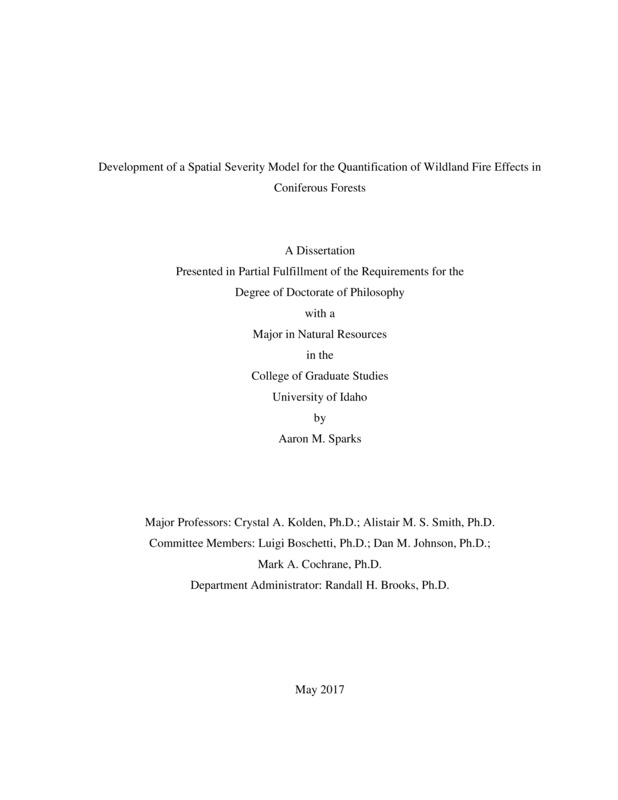Development of a Spatial Severity Model for the Quantification of Wildland Fire Effects in Coniferous Forests
Sparks, Aaron. (2017). Development of a Spatial Severity Model for the Quantification of Wildland Fire Effects in Coniferous Forests. Theses and Dissertations Collection, University of Idaho Library Digital Collections. https://www.lib.uidaho.edu/digital/etd/items/sparks_idaho_0089e_11098.html
- Title:
- Development of a Spatial Severity Model for the Quantification of Wildland Fire Effects in Coniferous Forests
- Author:
- Sparks, Aaron
- Date:
- 2017
- Keywords:
- conifers fire ecology fire intensity fire severity post-fire recovery
- Program:
- Natural Resources
- Subject Category:
- Forestry; Ecology; Natural resource management
- Abstract:
-
Fire is an integral change agent in the Earth system and plays key roles in nutrient cycling, plant species distribution, atmospheric composition and ecosystem service function at temporal scales ranging from years to centuries and spatial scales ranging from micro to continental. Increased fire activity (intensity, frequency, and size) in North American forested ecosystems has been observed and predicted under warmer and drier climate conditions. As forested ecosystems serve as significant carbon sinks, there is an urgent need to improve our understanding of fire intensity impacts on forest productivity and recovery post-fire. The research within this dissertation is focused on advancing our current understanding by identifying mechanistic relationships between fire intensity and post-fire tree response (e.g. mortality, physiology, growth and vulnerability) that enable spatiotemporal characterization of fire effects. This research tested the hypothesis that increasing quantities, or ‘doses’, of fire intensity lead to predictable responses in terms of tree mortality or physiological function. This hypothesis was first tested using nursery grown Pinus contorta and Larix occidentalis seedlings subjected to highly controlled laboratory surface fires. A dose-response relationship was demonstrated between fire radiative energy and post-fire seedling mortality and physiological function. Additionally, this relationship was shown to be detectable using spectral indices common to plant physiology research. The dose-response hypothesis was further tested at the mature tree scale by using prescribed fires in mature Pinus ponderosa forest stands. Increasing levels of peak fire radiative power were observed to lead to reduced post-fire radial growth. Permanent defense structures, axial resin ducts, were found to increase in density, size, and area per growth ring post-fire regardless of fire intensity. Finally, observations from satellite based remote sensing were used to test the dose-response hypothesis at the landscape spatial scale. Similar to observations at the tree scale, satellite measures of forest productivity decreased with increasing fire radiative power. Species composition was demonstrated to influence the magnitude of productivity loss post-fire. Ultimately, the work in this dissertation demonstrates a framework to spatially characterize individual tree and forest condition post-fire, improving our understanding of the carbon cycle and ability to sustainably manage forests.
- Description:
- doctoral, Ph.D., Natural Resources -- University of Idaho - College of Graduate Studies, 2017
- Major Professor:
- Kolden, Crystal A; Smith, Alistair MS
- Committee:
- Boschetti, Luigi; Johnson, Dan M; Cochrane, Mark A
- Defense Date:
- 2017
- Identifier:
- Sparks_idaho_0089E_11098
- Type:
- Text
- Format Original:
- Format:
- application/pdf
- Rights:
- In Copyright - Educational Use Permitted. For more information, please contact University of Idaho Library Special Collections and Archives Department at libspec@uidaho.edu.
- Standardized Rights:
- http://rightsstatements.org/vocab/InC-EDU/1.0/

